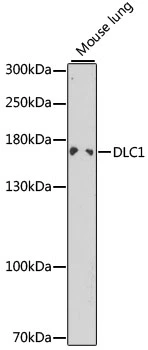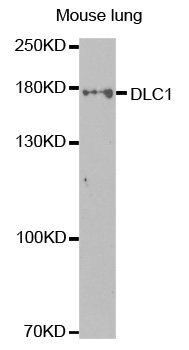
WB analysis of mouse lung tissue lysate using GTX54022 DLC1 antibody. The signal was developed with ECL plus-Enhanced. Dilution : 1:1000 Loading : 25microg per lane
DLC1 antibody
GTX54022
ApplicationsWestern Blot, ImmunoHistoChemistry, ImmunoHistoChemistry Paraffin
Product group Antibodies
ReactivityHuman, Mouse, Rat
TargetDLC1
Overview
- SupplierGeneTex
- Product NameDLC1 antibody
- Delivery Days Customer7
- Application Supplier NoteWB: 1:500 - 1:2000. IHC-P: 1:50 - 1:200. *Optimal dilutions/concentrations should be determined by the researcher.Not tested in other applications.
- ApplicationsWestern Blot, ImmunoHistoChemistry, ImmunoHistoChemistry Paraffin
- CertificationResearch Use Only
- ClonalityPolyclonal
- ConjugateUnconjugated
- Gene ID10395
- Target nameDLC1
- Target descriptionDLC1 Rho GTPase activating protein
- Target synonymsARHGAP7, HP, STARD12, p122-RhoGAP, rho GTPase-activating protein 7, Rho-GTPase-activating protein 7, START domain-containing protein 12, StAR-related lipid transfer (START) domain containing 12, deleted in liver cancer 1 protein, epididymis secretory sperm binding protein, rho-type GTPase-activating protein 7
- HostRabbit
- IsotypeIgG
- Protein IDQ96QB1
- Protein NameRho GTPase-activating protein 7
- Scientific DescriptionThis gene encodes a GTPase-activating protein (GAP) that is a member of the rhoGAP family of proteins which play a role in the regulation of small GTP-binding proteins. GAP family proteins participate in signaling pathways that regulate cell processes involved in cytoskeletal changes. This gene functions as a tumor suppressor gene in a number of common cancers, including prostate, lung, colorectal, and breast cancers. Multiple transcript variants due to alternative promoters and alternative splicing have been found for this gene.[provided by RefSeq, Apr 2010]
- ReactivityHuman, Mouse, Rat
- Storage Instruction-20°C or -80°C,2°C to 8°C
- UNSPSC12352203







